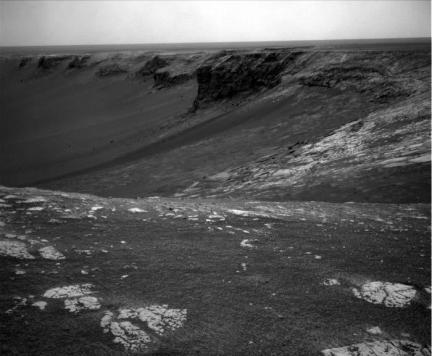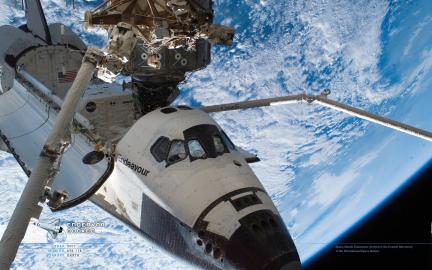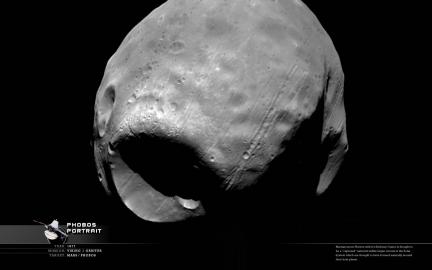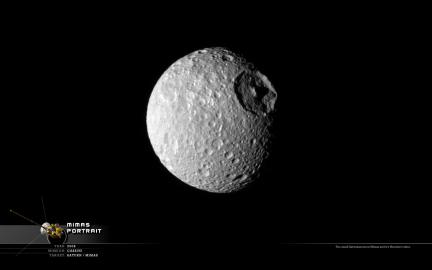Smallsteps Wallpaper: Luna 17 & Lunokhod 1
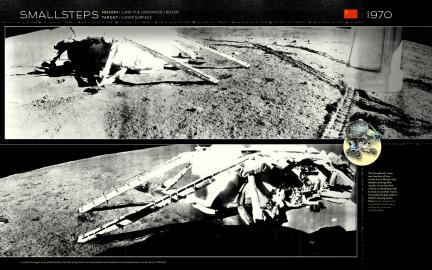 More than a year after Americans set foot on the moon in 1969, the Soviets landed the worlds first remote “rover” type vehicle ever to explore the surface of another world. One almost has to wonder how the politics of this mission even played out to bother even letting it continue. It would hardly seem worthwhile sending a robot to do the work actual humans would be conducting 5 more additional times beyond the historic Apollo 11 landing from the year previous.
More than a year after Americans set foot on the moon in 1969, the Soviets landed the worlds first remote “rover” type vehicle ever to explore the surface of another world. One almost has to wonder how the politics of this mission even played out to bother even letting it continue. It would hardly seem worthwhile sending a robot to do the work actual humans would be conducting 5 more additional times beyond the historic Apollo 11 landing from the year previous.
The rover was named “Lunokhod” and translated means, “Moon Walker”, it carried out a mission for 11 days and traveled 10.5 km. Despite the fact that nobody knows exactly where the rover rests today, the rover and lander were sold at auction in 1993 for $68,500. The auction catalog read that it was, “resting on the surface of the moon”.
Smallsteps Wallpaper: Luna 3
The Soviet spacecraft Luna 3 was the third such craft to be successfully sent to the moon in history. The images were not very great, as can be seen… but it was the first glimpse mankind ever had of the side of the moon that is permanently facing away from us. With the first look at the “dark side of the moon” many people were quite excited and the images were published the world over. It took a total of 29 pictures and was able to image at least 70% of that unseen side of the moon.
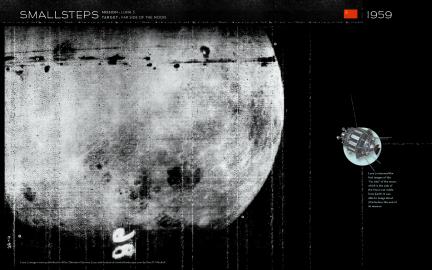
The image is largely intact but for the purposes of presentation I faked the “8” in the number on the bottom and actually added some noise lines.
Smallsteps Wallpaper: V2 Rocket
While looking at all the strange images from old Soviet moon missions on Don Mitchell’s site, I thought it would be interesting to design a set of wallpapers from these early images. I call the series “Smallsteps” as in Neil Armstrong’s famous, “One small step…” quote from Apollo 11. Obviously, there would have been no “giant leap” without a large number of these other “small steps” preceding the Apollo Program (although some of the images I have planned actually come after or during the Apollo program).
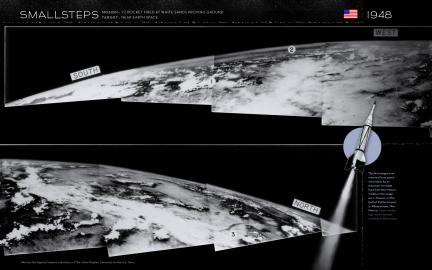
To me, the fact that the human race was even doing space exploration back then seems almost out of time — and then you look at the spacecraft that were sending back these images and it is amazing that anything really ever worked. Tin cans with cameras sending back images that were often just as bizzare and rough as the vessels that carried them. It is even more incredible when you consider that people eventually started strapping themselves to these rockets and floated around the vacuum of space in boxes wrapped with foil.
Seems appropriate enough to start the whole set off with the V2 images of Earth sent back in the shockingly early year of 1948. According the the Air and Space Museum these are the first images of the Earth taken from space in history. The image itself I suspect was just scanned from some print and the number tags and directionals are original (although there were about 17 of them and I removed a majority of them in Photoshop).
Closest Iapetus Flyby of Mission In 2 Days
 On Sept. 10, the Cassini spacecraft performs its closest flyby during the entire mission of the odd moon Iapetus, passing by about 1,640 kilometers. The moon is somewhat further out than most of the others, so despite the fact that Cassini has many months if not years in front of it still, the moon is too out-of-the-way to be making any additional passes. Who knows when another spacecraft will be this close again? Hope its a good look… it will have to last.
On Sept. 10, the Cassini spacecraft performs its closest flyby during the entire mission of the odd moon Iapetus, passing by about 1,640 kilometers. The moon is somewhat further out than most of the others, so despite the fact that Cassini has many months if not years in front of it still, the moon is too out-of-the-way to be making any additional passes. Who knows when another spacecraft will be this close again? Hope its a good look… it will have to last.
I made this “close to true color” image from the raw files using the BLU, IR1 and GRE filters. The distance seen here is approximately 694,000 kilometers.
Big Red Marble
 Just thought this was a pretty view of Mars taken by Hubble. It seems “shiny” like a marble. The orignal was found at this Flickr account.
Just thought this was a pretty view of Mars taken by Hubble. It seems “shiny” like a marble. The orignal was found at this Flickr account.
Io Aglow
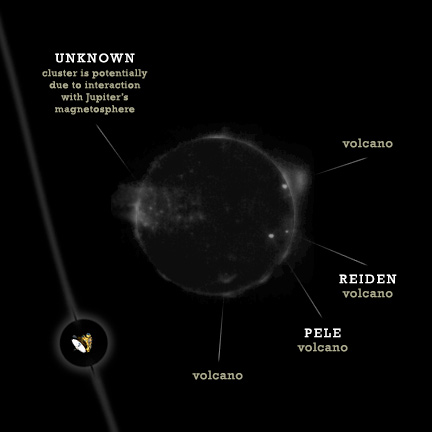 This is a bit old taken from February 2007’s New Horizons encounter at Jupiter. A very noisy image was released of Io on the dark side of Jupiter that illustrated the glowing lights of lava flows and auroral displays in Io’s tenuous atmosphere interacting with Jupiter’s magnetosphere.
This is a bit old taken from February 2007’s New Horizons encounter at Jupiter. A very noisy image was released of Io on the dark side of Jupiter that illustrated the glowing lights of lava flows and auroral displays in Io’s tenuous atmosphere interacting with Jupiter’s magnetosphere. 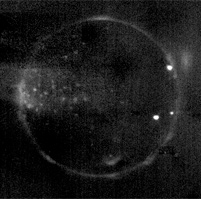 Noise always bothers me and there has been a desire to somehow clean up the presentation of this fantastic image.
Noise always bothers me and there has been a desire to somehow clean up the presentation of this fantastic image.
The process was simply to blur the image, layer highlight information a few times with varying degrees of sharpness or blur and to simply hand remove what would seem to be simply noise artifacts. The problem is that some of this information wasn’t just noise, but is actually auroral glow (especially at the disk edge). So after some of the noise was removed it was softened and re-introduced selectively around active areas where the assumption is that the glow near these spots is more intense. The final step was to simply reduce the file size so that it became sharper.
This presentation is purely artistic although it does come from real image data… I just wouldn’t use it to support any scientific papers. The items marked simply as “volcano” were newly discovered by New Horizons.
Another “Color” View of Rhea
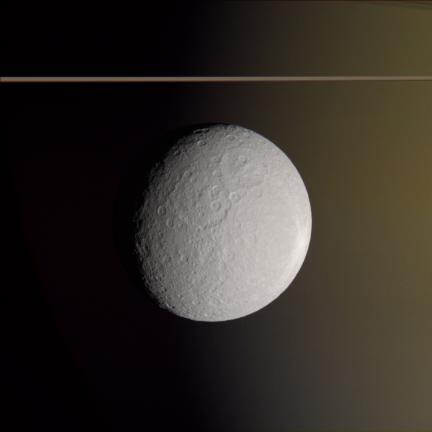 Just as with the previous color image of Rhea, the same process was used to create this view of Rhea against Saturn.
Just as with the previous color image of Rhea, the same process was used to create this view of Rhea against Saturn.
This image was added to a set of images posted later as it was taken as part of the same approach as the others.
Rhea From about 50,000 km
Cassini actually passed within 5,000 km of Rhea (a moon of Saturn) on the 30th and took a multitude of images. All the closest images are quite bright and it is unclear if the moon is just that bright, if there was an anomaly in the process or if some basic calibration has yet to occur. At any rate here are more distant images from the flyby and what happens if you register the various filtered images into one RGB (red, green, blue) file in Photoshop. The IR1 (infrered) is placed in the red channel, the GRN is placed in the green channel and the VIO (ultraviolet) is placed in the blue and you get what is truly false color, but not very far from what other natural color images have shown in the past.
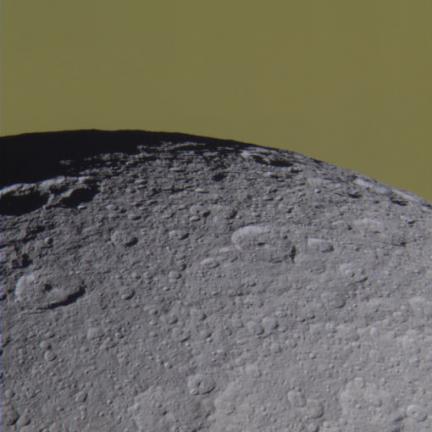
Saturn (the solid color behind Rhea) seems a bit more green than expected… however, if the moon was starting to pass onto the side of the planet in darkness, it does tend to move toward green hues when in shadow.
Here is another one the further away images at 58,731 km in clear filter (B&W). You can see into one of the craters along the edge at the lower left side and peer across at the opposite side wall. It is similar to the close flyby images obtained of Dione and its deep canyon walls from last year.
And another clear filter from 61,602 km:
While We Were Away
So, the bottomless pit on Mars is not bottomless (although still a hefty 78 meters deep)
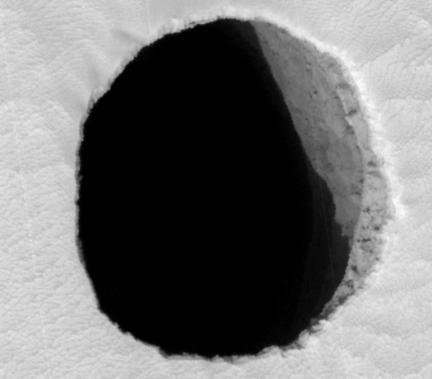
And the Martian rovers survive the dark dust storm of 2007 and resume their extended missions. The only question remaining is… what exactly (if anything) can destroy these everlasting robots! Below is a recently returned image of the Martian surface as it appears today.
On Holiday
I am currently on holiday in Doolin, Ireland am not expecting to make any posts during the week. Upon return wanderingspace will be putting a full-time effort into the Carnival of Space (see previous post).
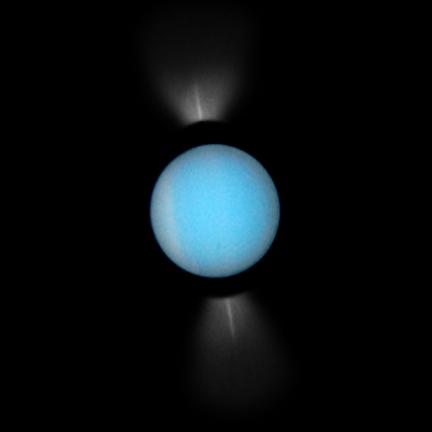 Until then, enjoy this rare occasion of Hubble’s view of Uranus as it’s rings are seen “edge on” for the first time in 42 years. Since the rings were only discovered in the late 70’s this would be the first time we have ever had the opportunity to view them this way.
Until then, enjoy this rare occasion of Hubble’s view of Uranus as it’s rings are seen “edge on” for the first time in 42 years. Since the rings were only discovered in the late 70’s this would be the first time we have ever had the opportunity to view them this way.
Carnival of Space for September 27
Wanderingspace will be hosting the Carnival of Space for September 27. I am thinking that the theme will be art and space or rather, the art of space… whichever seems more appropriate whenever we see which way the content leans. It seems an appropriate theme for this site as imagery is what really drives the concept of this site with just a touch of news and articles for the part-time space enthusiast. If anyone would like to participate in the carnival or has any ideas of what would make a great contribution to it, please leave your email and comments in the usual comment space provided on this post.
Martian Skies Will Clear Up
Put on a happy face.
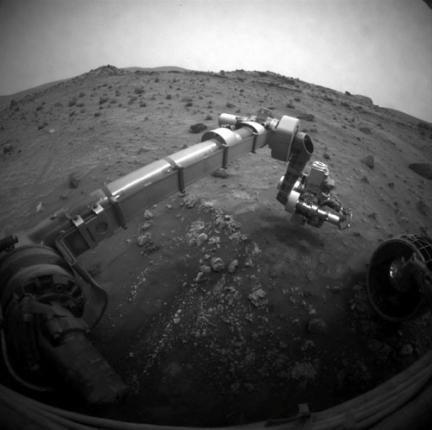
The robotic arm on Spirit has begun operations again. The dust storm has been breaking up and allowing sunlight to recharge its batteries enough to resume some scientific activity on the surface. Apparently things are not quite so clear yet on Opportunity’s side of the planet, but it is starting to look as if things will be back to normal soon enough for Spirit at the very least.
Wallpapers: Earth from the Space Shuttle
Something impressive seems to be happening on STS-118 (the Space Shuttle mission currently in orbit)… Photography.

Surely there are many excellent images to be had from previous Shuttle missions, but the images coming from STS-118 are really something to see. Perhaps one of the astronauts doing the EVAs (extra vehicular activities) has a degree in photography? At any rate, this site’s recent effort to give Earth it’s fair presence on this site has to take advantage of some of these fantastic images coming from NASA.
If you would like to see more check out the current mission’s multimedia gallery here or digg the story here.
No Planets, But You May Like It Anyway
My day job makes wicked cool tees for designers, nerds, geeks, centaurs, graphic artists, computer freaks, tech-dorks, fools and kings. Prices have been a cheap $15-17 for the first 3 months of operation, now we are moving the prices up to the still low price of $20-22. So get some now before its costs more! read more | digg story
Wallpapers: Some of the Minor Moons
Wallpaper: Earth Portrait
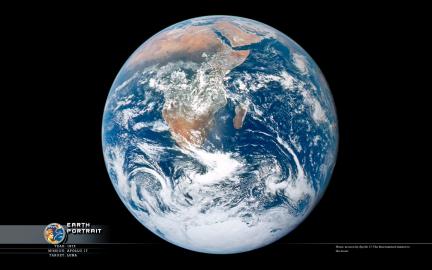 You have probably seen this image of the Earth before. This was the way the Earth appeared to the final astronauts to land on the moon in 1972. It has since become the quintessential Earth portrait, used more often than any other global image of the Earth. This is probably due to its beauty but also worth mentioning the relative rarity with which we get to see a full globe image taken of the Earth in one snapshot. Only missions and probes that leave the vicinity of the Earth are able to do this and some other popular Earth portraits have been taken by Galileo, Messenger… there is the famous Earth/Moon portrait taken by Voyager 1 and of course several from various Apollo missions.
You have probably seen this image of the Earth before. This was the way the Earth appeared to the final astronauts to land on the moon in 1972. It has since become the quintessential Earth portrait, used more often than any other global image of the Earth. This is probably due to its beauty but also worth mentioning the relative rarity with which we get to see a full globe image taken of the Earth in one snapshot. Only missions and probes that leave the vicinity of the Earth are able to do this and some other popular Earth portraits have been taken by Galileo, Messenger… there is the famous Earth/Moon portrait taken by Voyager 1 and of course several from various Apollo missions.
Wallpaper: Earthrise
Wallpaper: Martian North Pole
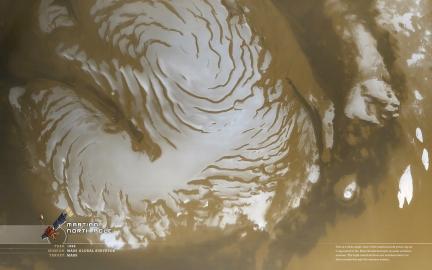 Since the Mars Phoenix Lander has now been successfully launched, and is on its way to potentially making the first ever successful landing in the Martian polar region… Here is a great image of the region taken from the Mars Recon Orbiter’s archives.
Since the Mars Phoenix Lander has now been successfully launched, and is on its way to potentially making the first ever successful landing in the Martian polar region… Here is a great image of the region taken from the Mars Recon Orbiter’s archives.
On a side note, there was one previous mission called the Mars Polar Lander which was to touch down in the region in 1999. Communication was lost with the lander just prior to the designated arrival date and the whereabouts of the probe have been a mystery ever since. Recently the Opportunity and Spirit rovers, the old Viking Landers and even the original Pathfinder components had been clearly imaged from orbit by the Mars Global Surveyor and that raised hopes we might finally make a visual connection with the remains of the doomed lander. Initially some hopeful findings had been made, but they later panned out and as of this date MPL still remains lost.
Wallpapers: 1024x768 Set 05
 Managed to make the more common wallpaper size 1024x768 for the 14 most recent wallpaper posts (started with set 05 images, 1-4 to come). Download zip file here. Some were not produced as they just didn’t translate so easily into the format. However, the opposite is true in some cases such as for this image of the Martian south pole. Its resolution was hopelessly low for the larger landscape format, so now with the smaller size it was possible (just barely) to get it posted as a wallpaper.
Managed to make the more common wallpaper size 1024x768 for the 14 most recent wallpaper posts (started with set 05 images, 1-4 to come). Download zip file here. Some were not produced as they just didn’t translate so easily into the format. However, the opposite is true in some cases such as for this image of the Martian south pole. Its resolution was hopelessly low for the larger landscape format, so now with the smaller size it was possible (just barely) to get it posted as a wallpaper.
Included in the set for download are the images pictured at the top and for the sake of google search, here they are listed out:
- 1024x768 Wallpaper of CALLISTO at half view, moon of JUPITER
- 1024x768 Wallpaper of EARTH from APOLLO landing site
- 1024x768 Wallpaper portrait of EUROPA, moon of JUPITER
- 1024x768 Wallpaper portrait of JUPITER
- 1024x768 Wallpaper of MARS region of DEUTERONILUS (not shown)
- 1024x768 Wallpaper of MARS surface at HUSBAND HILL
- 1024x768 Wallpaper portrait of MARS
- 1024x768 Wallpaper portrait of PHOEBE, moon of SATURN
- 1024x768 Wallpaper portrait of RHEA, moon of SATURN
- 1024x768 Wallpaper of SATURN, crescent view (not shown)
- 1024x768 Wallpaper of SATURN from above the NORTHERN POLE
- 1024x768 Wallpaper of SATURN globe
- 1024x768 Wallpaper of SPACE WALK
- 1024x768 Wallpaper portrait of TETHYS, moon of SATURN



